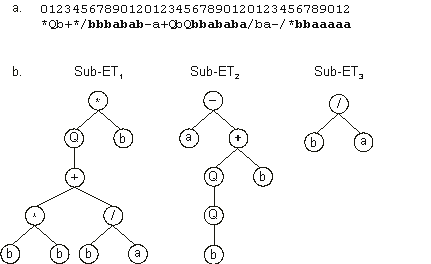In nature, chromosomes usually code for more than one gene, as complex individuals require complex genomes. Indeed, the evolution of more complex individuals is only possible through the creation of multigenic genomes. Not surprisingly, gene expression programming also explores the advantages of multigenic systems.
GEP chromosomes are usually composed of more than one gene of equal length. For each problem, the number of genes, as well as the length of the head, are chosen a priori. Each gene codes for a sub-ET and the sub-ETs interact with one another forming a more complex entity. The details of such interactions will be fully explained in
section 2.2. For now we will focus exclusively on the construction of sub-ETs from their respective genes.
Consider, for example, the following chromosome with length 39, composed of three genes, each with
g = 13 (the tails are shown in blue):
| 012345678901201234567890120123456789012 |
|
|
*Qb+*/bbbabab-a+QbQbbababa/ba-/*bbaaaaa |
(2.9) |
It codes for three ORFs, and each ORF codes for a sub-ET (Figure
2.2). Position 0 marks the start of each ORF; the end of each ORF, though, is only evident upon construction of the respective sub-ET. As shown in
Figure 2.2, the first ORF ends at position 9
(sub-ET1); the second ORF ends at position 6 (sub-ET2); and the last ORF ends at position 2
(sub-ET3).

Figure 2.2. Expression of GEP genes as sub-ETs. a) A three-genic chromosome with the tails shown in bold. Position 0 marks the start of each gene.
b) The sub-ETs codified by each gene.
In summary, GEP chromosomes contain several ORFs, each ORF coding for a structurally and functionally unique sub-ET. We will see that, depending on the problem at hand, these sub-ETs may be selected individually according to their respective fitness (for example, in problems with multiple outputs), or they may form a more complex, multi-subunit ET and be selected according to the fitness of the whole, multi-subunit ET. The patterns of expression and the details of selection will be often discussed throughout this book. However, keep in mind that each sub-ET is both a separate entity and part of a more complex, hierarchical structure, and, as in all complex systems, the whole is more than the sum of its parts.
|
